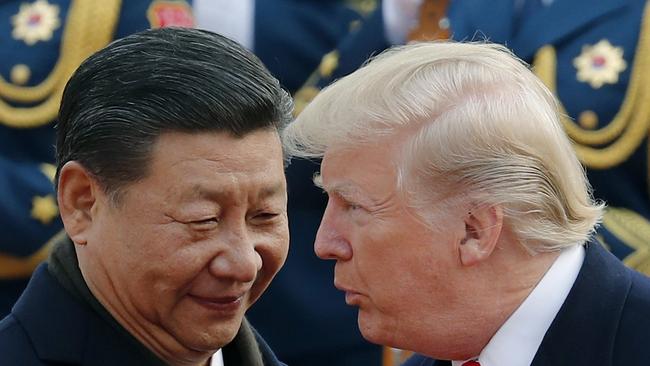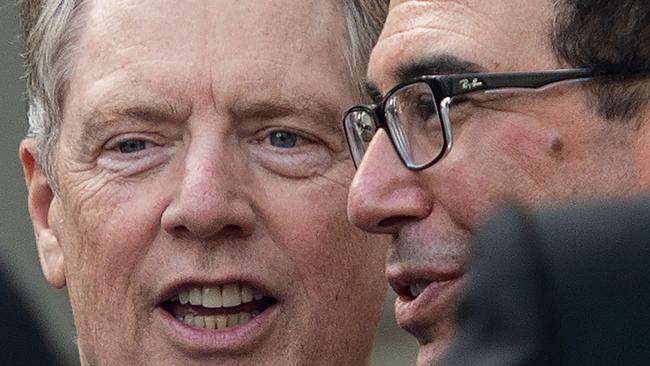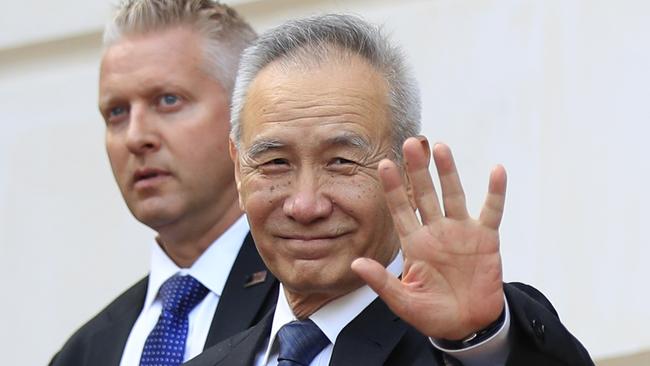Tariff hike enforced as US-China trade talks continue
China threatens payback as US enforces tariff hike and warns of new hit, even as talks continue.

Donald Trump decided to let a tariff hike on $US200 billion of Chinese goods go into effect at midnight in Washington, even as trade negotiations resumed.
The President also threatened to move ahead with fresh levies on everything else China sells to the US that isn’t already subject to tariffs.
China’s Ministry of Commerce said it will take countermeasures after the US increased tariffs, but did not specify what measures Beijing would take.
It said it regretted the US move and hoped the two nations could work together in the ongoing talks in Washington to resolve existing disputes through cooperation and negotiation.
US and Chinese negotiators met today and plan to meet again tonight (AEST), but even so tariffs would increase to 25 per cent from 10 per cent as planned, a White House spokeswoman said.
China’s stockmarkets initially slid following a noon break in trade but later rebounded to stage their biggest rally in six weeks, with the Shanghai Composite Index jumping 3.1 per cent.
The decision to proceed came after US Trade Representative Robert Lighthizer and Treasury Secretary Steven Mnuchin met with President Trump to discuss “the ongoing trade negotiations with China,” said a White House statement. The negotiators would continue discussions Friday morning at the trade representative’s office.
In addition to the tariff increase on the $US200 billion of Chinese imports, Mr Trump said the US was “starting the paperwork” to impose 25 per cent tariffs on $US325 billion in Chinese goods that aren’t currently taxed.
“I’m different than a lot of people,” Mr Trump said at the White House. “I happen to think the tariffs for our country are very powerful.”
China has rejected US claims that it has backtracked in negotiations - the source of a setback this week that threatened to scuttle a potential trade agreement between the two countries - and has threatened unspecified countermeasures to the new US tariffs.
“I came here this time, under pressure, to show China’s great sincerity, “ Chinese Vice Premier Liu He said in an interview with state broadcaster CCTV after arriving in the US.
Mr Trump’s tactics reflected US negotiators’ frustration that Beijing had reneged on earlier commitments that had been expected to produce a preliminary agreement during talks this week in Washington.
But the move also made clear that Mr Trump sees tariffs as a winning tactic, both internationally with trade partners and at home with Congress.
Treasury secretary

Senator Chuck Schumer, the chamber’s Democratic leader, has backed a tougher stance toward China -- although he could quickly withdraw his support if Mr Trump, a Republican, fails to reach a deal that fundamentally changes Chinese economic policy.
The US threats acted as a backdrop to resumed negotiations between Washington and Beijing, which began with meetings between midlevel negotiators and continued with Mr Liu on Thursday. Talks had progressed smoothly over recent months but nearly derailed last week.
The US thought China had agreed to detail the laws it would change to implement the trade deal under negotiation, according to administration officials. But late last week, Beijing said it had no intention of doing so, triggering Mr Trump’s threat Sunday to escalate tariffs and bringing the dispute into the open.
US negotiators viewed China as reneging on earlier commitments. From Beijing’s vantage point, the move was an effort to renegotiate US demands that it believed impinged on Chinese sovereignty.
The negotiating setback reinforced concerns in Washington that Mr Liu didn’t have the political strength to push commitments through the labyrinthine Chinese bureaucracy and Communist Party structure.
Mr Liu is a longtime colleague and trusted adviser of President Xi Jinping, but he was known mainly as an academic, not a party leader. US officials were quick to say that Mr Trump’s threat to escalate tariffs wasn’t aimed at Mr Liu, who is considered an economic reformer, but at conservative policy makers in China who prefer a tougher stance toward the US.
Mr Trump also tempered his threats by saying that Mr. Xi had written him “a very beautiful letter” Wednesday and that he would probably speak with Mr. Xi to see whether personal diplomacy might help.
“Let’s work together,” Mr Trump said. “Let’s see if we can get something done.”
Mr Liu had dinner with Mr Lighthizer Thursday evening.
It wasn’t known whether Mr Liu would be carrying instructions from Mr Xi to offer the concessions the US thinks are necessary for a deal, or would just sound out US officials to better understand their intentions. Unlike in prior visits, Mr Liu wasn’t given the title of Mr. Xi’s “special envoy,” suggesting he may not have the power to make significant compromises.
Beijing’s Commerce Ministry has threatened to take unspecified countermeasures should the US move ahead with its planned tariff increase on the $US200 billion of goods. China’s retaliation so far has targeted US agriculture, causing exports of US soybeans, sorghum and pork to fall.

Financial markets were volatile as investors struggled to make sense of the continuing trade negotiations. The Dow Jones Industrial Average tumbled more than 400 points early, dragged lower by shares of manufacturers and technology firms whose businesses rely heavily on Chinese growth. As investors sought relatively safe assets, Treasury yields slipped, sending bond prices higher.
But after Mr Trump suggested the White House could still reach a deal with Beijing, stocks and bond yields bounced off their lows for the day. To traders, the back-and-forth pointed to the continuing uncertainty over the fate of the two countries’ trade talks.
The impact of the US tariff increase to 25 per cent is unlikely to be felt right away. The goods facing that increase had already been subject to a 10 per cent tariff since September. Companies that have discussed the levies in earnings calls this year have said they planned for the tariff increase in their financial forecasts.
The bulk of the goods facing increased levies are capital and intermediate goods such as circuit boards, microprocessors, vehicle parts, and machinery. About $US40 billion of consumer goods will also be hit. All told, over 5000 different items are subject to the tariffs.
The tariffs apply to goods leaving China and entering the US after midnight on Friday. Airfreight shipments will be hit right away, but cargo that was loaded onto ships in China before Friday and is already bound for US ports won’t be subject to the levies.
But should the US press ahead to levy tariffs on the remainder of Chinese imports -- $US325 billion of goods, according to Mr. Trump -- that would fall very heavily on consumers. Those goods include iPhones and other mobile phones, clothing, laptops and many other everyday products that consumers rely upon. The US has tried to keep those items free from fresh tariffs to avoid a consumer backlash that could undermine the US trade effort.
Any new tariffs would be weeks if not months away. The US trade representative’s office would need to identify the goods, seek comments on its choices and hold hearings. The administration has moved carefully on tariffs to try to avoid being sued for failing to follow administrative procedures.
The trade conflict started more than a year ago when the trade representative’s office published a lengthy study saying that China systematically pressed US companies to hand over technology to their competitors, and favoured its domestic firms with improper subsidies and other aid. The study also said US companies were unfairly blocked from participating in Chinese financial and digital markets.
Those issues have now taken a back seat to the dispute over whether China would commit in a trade pact to change its laws, and whether the U.S. could be persuaded not to raise tariffs.
China “started to renegotiate the deal. We can’t have that,” Mr. Trump said.
Dow Jones




To join the conversation, please log in. Don't have an account? Register
Join the conversation, you are commenting as Logout